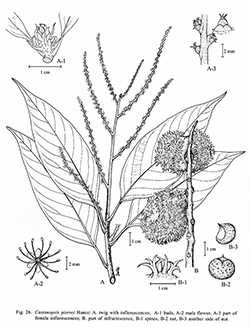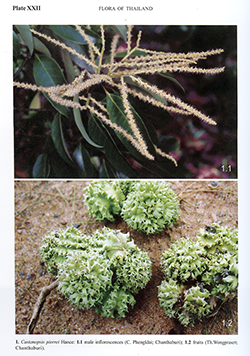e-Flora of Thailand
Volume 9 > Part 3 > Year 2008 > Page 225 > Fagaceae > Castanopsis
23. Castanopsis pierrei Hancewfo-0000814811
J. Bot. 13: 369. 1875; Hickel & A.Camus, Bull. Soc. Bot. France: 490. 1921; Fl. Indo-Chine 5: 1031. 1930; Barnett, Quer. Rel. Fag. Asia: 182. 1940; Trans. & Proc. Bot. Soc. Edinburgh 34: 336. 1944; Hjelmq., Dansk Bot. Ark. 23.4: 498. 1968. Fig. 26; Plate XXII.
Accepted Name : This is currently accepted.
Description : Tree, 7–25 m high, 70–180 cm girth. Axillary buds ovoid, laterally compressed. Twigs pubescent then glabrescent, lenticellate. Bark greyish-brown, rather smooth; inner bark reddish brown with white stripes. Leaves lanceolate or oblong, 10–20 by 3–6 cm; base cuneate, obtuse to oblique; apex acute, acuminate to cuspidate; margins entire; coriaceous, glabrous, dull green on the upper surface, pale or glaucous on the lower; midrib prominent on both surfaces; lateral nerves 7–11 pairs, distinct on the lower surfaces, subdepressed on the upper, scalariform veins conspicuous on the lower surface. Petiole 1–2 cm, glabrous, blackish when dry. Inflorescences male and female mixed or separate, erect, axillary or terminal, spike or rarely branched. Male inflorescence a spike or with spikelets 6–15 cm long, pubescent. Male flowers yellow, scented, 1–3-flowered in a bract; bracts and bracteoles ovate, pubescent outside; calyx 6-lobed, ovate or obovate, ca 2 by 1 mm, pubescent outside; stamens 12, 3–3.5 mm long, glabrous; rudimentary ovary globose, flattened on top, ca 1 mm in diam., hirsute. Female inflorescence spike 15–20 cm long. Female flower solitary or in 2–3-flowered cluster, other characters as in male flowers; styles 3, divergent; stigmata pointed. Fruits sessile, globose or bilobed, 4–6 cm in diam. (including cupule) on erect woody infructescence 15–30 cm long. Cupule completely enclosing the nut but not fused with it, sparsely hairy inside; wall sparsely covered with woody, branched, curved spines; dehiscent. Nuts 1–3–(4) per cupule, ovoid in outline, sometimes curved to one side, densely white hairy around the umbo.
Thailand : NORTH-EASTERN: Nakhon Phanom; SOUTH-EASTERN: Chanthaburi, Trat; PENINSULAR: Ranong, Surat Thani, Phangnga, Phuket, Trang.
Distribution : Cambodia (type).
Ecology : Tropical evergreen rain forests, pine-deciduous dipterocarp forests, moist upper mixed deciduous forests, along stream banks, 10–350 m (most commonly 40–100 m). Flowering: January–December (most commonly December–January); fruiting: April December (most commonly April–June).
Vernacular : Ko khao niao (ก่อข้าวเหนียว)(Northeastern); ko khi mu (ก่อขี้หมู), ko mu (ก่อหมู), ko khao niao (ก่อข้าวเหนียว), ma ko (มะก่อ)(Southeastern).
Uses: Nuts edible.


